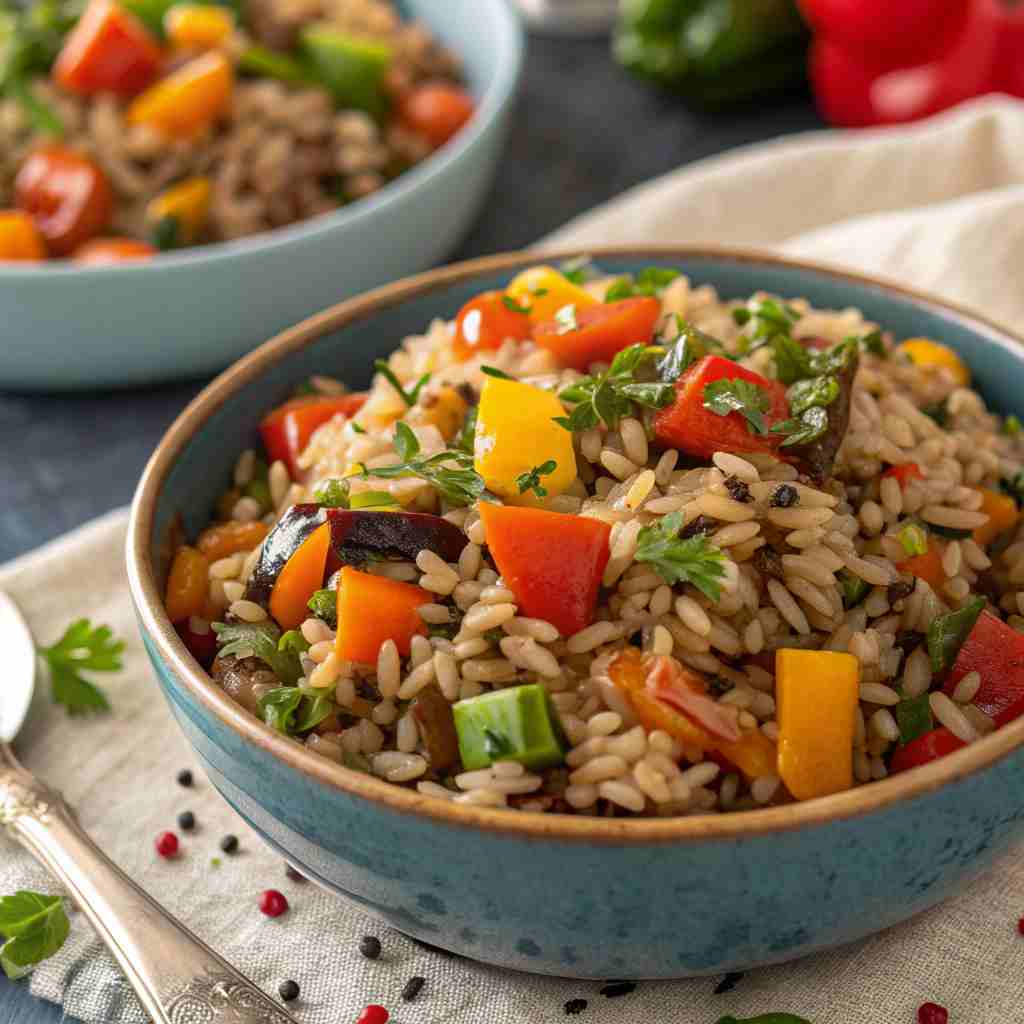Wild Rice Pilaf with Veggies is a wholesome, nutty-flavored side dish that combines the earthy richness of wild rice with colorful vegetables and aromatic herbs. This protein-packed grain dish offers a perfect balance of textures and flavors, making it an ideal complement to any main course. With its hearty texture and satisfying taste, this pilaf transforms simple ingredients into an elegant side dish that’s both nutritious and delicious.
The beauty of this wild rice pilaf lies in its adaptability. You can customize it with seasonal vegetables, different herbs, or various nuts and dried fruits to suit your taste preferences. Whether you’re serving it alongside roasted chicken, grilled salmon, or as part of a vegetarian feast, this pilaf delivers both visual appeal and incredible flavor.
Key Ingredients for Wild Rice Pilaf with Veggies
- 1 cup wild rice, rinsed and drained
- 3 cups low-sodium vegetable or chicken broth
- 2 tablespoons olive oil
- 1 medium onion, diced (about 1 cup)
- 2 medium carrots, diced (about ¾ cup)
- 2 celery stalks, diced (about ¾ cup)
- 3 cloves garlic, minced
- ½ cup dried cranberries
- ½ cup chopped pecans or walnuts
- ¼ cup fresh parsley, chopped
- 2 tablespoons fresh thyme (or 2 teaspoons dried)
- 1 bay leaf
- 1 teaspoon salt (or to taste)
- ½ teaspoon black pepper
- ¼ cup green onions, sliced (for garnish)
How to Make Wild Rice Pilaf with Veggies
This wild rice pilaf combines nutty grains with colorful vegetables in a simple one-pot method. The earthy wild rice absorbs savory broth while vegetables add sweetness and crunch. Dried cranberries provide bursts of tartness, while nuts contribute satisfying texture. Total preparation and cooking time is approximately 75 minutes.
Step-by-Step Instructions
Step 1: Prepare the Wild Rice
Rinse 1 cup of wild rice under cold water in a fine-mesh strainer until the water runs clear. This removes any debris and excess starch. Set aside while you prepare the vegetables.
Step 2: Sauté the Vegetables
Heat 2 tablespoons of olive oil in a large, heavy-bottomed saucepan over medium heat. Add the diced onion, carrots, and celery. Cook for 5-7 minutes, stirring occasionally, until the vegetables begin to soften and the onion becomes translucent.
Step 3: Add Aromatics
Add the minced garlic, fresh thyme, and bay leaf to the sautéed vegetables. Cook for another minute until fragrant, being careful not to let the garlic burn.
Step 4: Toast the Wild Rice
Add the rinsed wild rice to the pan with the vegetables. Stir constantly for 2-3 minutes to lightly toast the rice, which enhances its nutty flavor and helps prevent the grains from becoming mushy.
Step 5: Add Liquid and Seasonings
Pour in 3 cups of broth, add salt and pepper, and bring the mixture to a boil. Once boiling, reduce the heat to low, cover the pan, and simmer for 45-50 minutes until the wild rice is tender and most of the liquid is absorbed.
Step 6: Add Final Ingredients
Remove the bay leaf and stir in the dried cranberries, chopped nuts, and fresh parsley. Let the pilaf rest for 5 minutes off the heat to allow flavors to meld.
Step 7: Serve and Garnish
Fluff the pilaf with a fork, taste and adjust seasonings if needed, then transfer to a serving bowl. Garnish with sliced green onions before serving.
Why You’ll Love This Wild Rice Pilaf with Veggies
This wild rice pilaf delivers exceptional flavor through its combination of nutty grains, sweet vegetables, and tart cranberries. Making it at home costs significantly less than purchasing pre-made grain salads from specialty stores while allowing complete control over ingredients and sodium content. The medley of textures – from chewy wild rice to crunchy nuts and tender vegetables – creates a satisfying eating experience that’s both hearty and elegant.
Unlike traditional white rice pilaf, this version provides superior nutrition and deeper, more complex flavors. Try making this alongside our Mediterranean quinoa salad for a complete grain-forward meal that showcases different international flavors and cooking techniques.
What to Serve Wild Rice Pilaf with Veggies With
This versatile pilaf pairs beautifully with roasted meats like herb-crusted chicken, glazed pork tenderloin, or grilled salmon. For vegetarian meals, serve it alongside stuffed portobello mushrooms or roasted butternut squash. The nutty flavors complement rich dishes like beef stew or lamb chops perfectly.
Consider pairing it with fresh salads featuring mixed greens and vinaigrette to balance the hearty grains. For beverages, try serving with crisp white wines like Sauvignon Blanc or light red wines such as Pinot Noir. The pilaf also works excellently as part of a holiday spread alongside roasted vegetables and cranberry sauce.
Top Tips for Perfecting Wild Rice Pilaf with Veggies
Timing is crucial – wild rice takes longer to cook than regular rice, so don’t rush the process. Test for doneness by biting a grain; it should be tender but still have slight chewiness.
Liquid ratios matter – use a 3:1 ratio of liquid to wild rice for optimal texture. If the rice seems too dry during cooking, add warm broth in ¼-cup increments.
Ingredient substitutions work well in this recipe. Replace cranberries with chopped dried apricots or raisins. Swap pecans for almonds, pine nuts, or sunflower seeds based on preference or allergies.
Prevent mushiness by avoiding over-stirring during cooking and letting the pilaf rest off heat before serving. This allows grains to firm up slightly while maintaining moisture.
Make-ahead friendly – this pilaf actually improves in flavor when made a day ahead, making it perfect for entertaining or meal prep.
Health Benefits of Wild Rice Pilaf with Veggies
Wild rice provides exceptional nutritional value with higher protein content than most grains – approximately 6 grams per cooked cup. It’s rich in antioxidants, particularly anthocyanins, which give it its dark color and provide anti-inflammatory benefits.
This pilaf delivers significant fiber content, supporting digestive health and helping maintain stable blood sugar levels. The vegetables contribute vitamins A and C, while nuts provide healthy fats and additional protein. Being naturally gluten-free, wild rice suits various dietary restrictions.
The combination of complex carbohydrates, protein, and healthy fats creates a satisfying dish that promotes sustained energy levels without blood sugar spikes.
Storing and Reheating Tips
Store leftover wild rice pilaf in the refrigerator for up to 4 days in an airtight container. The flavors actually develop and improve over time, making leftovers particularly delicious.
For reheating, add 2-3 tablespoons of broth or water to prevent drying out. Microwave in 30-second intervals, stirring between each, or reheat gently on the stovetop over low heat with additional liquid.
Freezing instructions: This pilaf freezes well for up to 3 months. Portion into freezer-safe containers, leaving space for expansion. Thaw overnight in the refrigerator before reheating. The texture may be slightly softer after freezing, but the flavor remains excellent.
For best results when meal prepping, store the nuts separately and add them just before serving to maintain their crunch.
Final Thoughts
Wild Rice Pilaf with Veggies transforms simple ingredients into an elegant, nutritious side dish that elevates any meal. Its combination of textures, flavors, and health benefits makes it a worthwhile addition to your recipe collection. Whether serving it for everyday dinners or special occasions, this pilaf delivers consistent results and satisfying taste that will have everyone requesting the recipe.
try also : Easy Pumpkin Dump Cake Recipe and find more in pinterest
Wild Rice Pilaf with Veggies FAQs
Q: Can I use a rice cooker for this recipe?
A: Yes, but use the brown rice setting and add vegetables after cooking. Wild rice requires longer cooking times than regular rice.
Q: How do I know when wild rice is properly cooked?
A: Properly cooked wild rice will have burst open slightly and feel tender but still chewy. It should not be mushy or hard.
Q: Can I make this recipe vegan?
A: Absolutely! Use vegetable broth instead of chicken broth, and the dish is completely plant-based.
Q: What’s the difference between wild rice and brown rice?
A: Wild rice is actually a grass seed with a nuttier flavor, higher protein content, and longer cooking time than brown rice.

